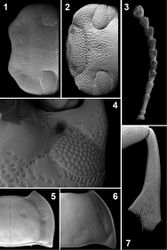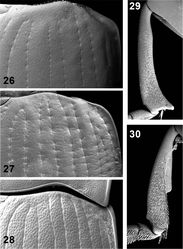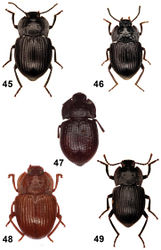Ectateus calcaripes
| Notice: | This page is derived from the original publication listed below, whose author(s) should always be credited. Further contributors may edit and improve the content of this page and, consequently, need to be credited as well (see page history). Any assessment of factual correctness requires a careful review of the original article as well as of subsequent contributions.
If you are uncertain whether your planned contribution is correct or not, we suggest that you use the associated discussion page instead of editing the page directly. This page should be cited as follows (rationale):
Citation formats to copy and paste
BibTeX: @article{Kamiński2014ZooKeys415, RIS/ Endnote: TY - JOUR Wikipedia/ Citizendium: <ref name="Kamiński2014ZooKeys415">{{Citation See also the citation download page at the journal. |
Ordo: Coleoptera
Familia: Tenebrionidae
Genus: Ectateus
Name
Ectateus calcaripes (Gebien, 1904) comb. n. – Wikispecies link – ZooBank link – Pensoft Profile
- Selinus calcaripes Gebien, 1904: 3. – Gebien 1910[1]: 277, 1938[2]: 297; Koch 1956[3]: 238; Kulzer 1963[4]: 425, Iwan 2002b[5]: 265.
Notes
The types of Selinus calcaripes seems to be lost. According to the information provided by Iwan (2002b)[5] they should be deposited in Naturhistorisches Museum collection (Basel, Switzerland). Unfortunately, the curators do not confirm this statement. Additionally, during the preparation of my recent scientific project – Phylogeny, biogeography and generic classification of the Ectateus generic group (Coleoptera: Tenebrionidae: Platynotina) – I have studied diverse entomological material concerning the subtribe Platynotina from several collections across the World and I did not menaged to locate these specimens.
Based only on the original species descriptions Koch (1956)[3] proposed to consider Selinus calcaripes as a synonym of Ectateus curtulus (Fairmaire, 1893). Unfortunately, the morphology of the holotype of Ectateus curtulus (damaged female – Fig. 47) do not correspond to Gebien’s (1904)[6] description of Selinus calcaripes and Koch’s (1956)[3] interpretation of Ectateus curtulus. Both publications refer rather to a morphological form that is very closely to Ectateus modestus and differers from it mainly by the structure of male protibiae (Figs 31–32). A consistent to the above mentioned descriptions morph was found in the studied material. It was included in the cladistic analysis as Selinus calcaripes.
The results of a cladistic analysis confirmed the aforementioned assumption that Ectateus curtulus and Selinus calcaripes represent two distinct morphological forms (Fig. 25). They can be easily distinguished by the structure of head (char. 3, 5), pronotum (char. 9) and elytra (elytral intervals with conspicuous punctures in Ectateus curtulus). Additionally, the results shows that Selinus calcaripes is very closely related to Ectateus modestus – which is consistent with Gebien’s (1904)[6] description and Koch’s (1956)[3] interpretation.
Taking into consideration the difficulties associated with Selinus calcaripes I propose to designate a neotype to clarify the taxonomic status of this species. Additionally, on the basis of the results of a cladistic analysis I propose to treat this taxon as a independent species – not as a synonym of Ectateus curtulus.
Studied material
Neotype designated here, male (MNHN): “Rep. Centrafric., La Maboke, 2.IX.1967, L. Matile rec.”. Other material: male (MNHN): “Musée du Congo, Haut-Uele: Yebo moto, VII-1926, L. Burgeon”, male (MRAC): “Musée du Congo, Haut-Uele: Yebo moto, V-1926, L. Burgeon”, male (MRAC): “Musée du Congo, Bambesa, 15-X-1933, J. V. Leroy”, male and 3 females (MRAC): “Coll. Mus. Tervuren, Oubanghi-Chari: Bangui I/III.1968, ex. coll. Breuning”, male and female (RBINS): “R.I.Sc.Nat. Belg.,I.G. 16.364”, 4 females (MNHN): “Calcaripes, Geb., det. Dr. Kaszab”, male and female (MNHN): “Boukoko, Rep. Centr Afric.”, male and female (MNHN): “La Maboke, Rep. Centr Afric.”, 2 males and female (MNHN): “Lamaboké, 10.XI.1965”, male and female (MNHN): “Lamaboké, 20-21.XI.1966”, male (MNHN): “Lamaboké, 18.XI.1965”, 2 females (HNHM): “Cameroon, Dja Reserve, Ekom, 21-26.XII. 1996, G. Hácz & G. Köszegi”, 3 males (MNB): “Kamerun Buea, 1-7.III.1912, v. Rothkirch S.G.”, female (MNB): “Kamerun, Brea 1000m, 2. - 7. III- 1912; v. Rothkirch S.G.”, female (MNB): “Kamerun, Soppo 25. II. 1912, v. Rothkirch S.G.”, 2 males (MNHN): “Lamaboké, Rep. Centrafric., V-1964, J. Carayon”, female (MNHN): “1968-69, La Maboké, Rép. Centre Afr., P. Teochhi leg.”, male (MNHN): “21.VIII.1969, La Maboké, Rép. Centre Afr., P. Teochhi leg.”, female (RBINS): “Coll. R. I. Sc. N. B., congo belge Beni, crottes d’ éléphants, 18-I-1952 Ch. Verbeke”, female (MNHN): “Muséum Paris, La Maboké, Rép. Centrafric.”, male (MRAC): “Musée du Congo, Région de Sassa, 1895-96, Colmant”, male and female (MNHN): “Cameroun, Dr. G. Nonveiller”, female (MNHN): “Muséum Paris, Congo Moyen, Rég. de M`Baiki, (D Fidao), Pitard 1919”, male (MNHN): “Uganda Prot., Mabira Forest, Chagwe., 3,500-3,800 ft.”, female (MNHN): “Uganda, Nimuli to, Murchison Falls”, male (MNB): “Neu-Kamerun, No. 3360-71, Tessmann S.G.”
Redescription
Habitus as in Fig. 45. Body length = 11.5–14.0 mm. Elytra wider and longer than pronotum (width ratio elytra / pronotum = 1.1–1.2; length ratio elytra / the middle of pronotum = 2.4–2.6).
Dorsal side of head dull, with punctures (the intervals between the punctures are smaller than the diameter of the puncture). Frontoclypeal suture coarse. Clypeal emargination relatively deep (clypeal emargination width / depth ratio = 8.0–8.6). Mentum with median part narrow. Submentum with short base. Maxillary palp not widened (width of maxillary palp / length of 3rd antennomere = 1.0–1.1). Length of antennae greater than pronotal length (ratio antenna / pronotum from tip of anterior pronotal angle to tip of posterior pronotal angle = 1.1–1.2). 3rd antennomere relatively long (length ratio of antennomere 3rd / 2nd = 2.8–3.0).
Pronotal disc transverse (middle of pronotum length / width ratio = 0.4–0.5); dull, with coarse punctures (the intervals between the punctures are smaller than the diameter of the puncture). Anterior pronotal angles sharp and protruding outwards. Lateral margins of pronotal disc sinusoidal. Apophyseal and basal depressions on pronotal disc present; apophyseal depressions rounded. Pronotal hypomera dull; without punctures.
Elytra oblong (elytra length / width ratio = 1.1–1.2). Elytral striae with fine punctures; intervals non-convex, with transverse sculpture (Fig. 27). Elytral base slightly rounded. Elytral humeri rounded, not protruding laterad. Wings absent. Scutellum triangular; situated in a depression.
Intercoxal process protruding towards mesoventrite; peaked at the apex. Metaventrite reduced (length ratio cavity of hind coxa / metaventrite between the insertions of mid and hind coxae ca. 2). In both sexes abdominal process without tubercles; relatively narrow (process of 1st abdominal ventrite / process of metaventrite = 2.1–2.2). 5th abdominal ventrite without bordering; punctures fine (the intervals between the punctures are greater than the 2 diameters of the puncture).
Male legs. Protarsi slightly narrow. Protibiae as in Fig. 31. Mesotibiae and mesofemorae with large denticle. Metafemorae with an hair fringe. Female legs simple.
Male genitalia. Parameres narrowest in the half of their length; length equal to the 0.2 of the rest of aedeagal tegmen (Fig. 20). Clavae hook-shaped (Fig. 20). Female genitalia. Paraproct equal to coxites. Bursa copulatrix with a sclerite in the distal part. Spermatheca with narrow ducts.
Distribution
This species has been collected in the following ecoregions of Central Africa (Cameroon, Central African Republic, Democratic Republic of the Congo, South Sudan): Atlantic Equatorial coastal forests, East Sudanian savanna, Mount Cameroon and Bioko montane forests, Northeastern Congolian lowland forests, Northwestern Congolian lowland forests (Fig. 41).
Taxon Treatment
- Kamiński, M; 2014: A cladistically based reinterpretation of the taxonomy of two Afrotropical tenebrionid genera Ectateus Koch, 1956 and Selinus Mulsant & Rey, 1853 (Coleoptera, Tenebrionidae, Platynotina) ZooKeys, 415: 81-132. doi
Images
|
Other References
- ↑ Gebien H (1910) Tenebrionidae I. In: W. Junk, S. Schenkling, Coleopterorum Catalogus, Berlin 18: 167–354.
- ↑ Gebien H (1938) Katalog der Tenebrioniden. Teil II. Mitteilungen der Muncher Entomologischen Gesellschaft 28: 49–80, 283–428 [370–465].
- ↑ 3.0 3.1 3.2 3.3 Koch C (1956) Exploration du Parc National de l’Upemba. II. Tenebrionidae (Coleoptera, Polyphaga), Opatrinae, First part: Platynotini, Litoborini and Loensini. Bruxelles, 472 pp.
- ↑ Kulzer H (1963) Verzeichnis des Typenmaterials der Tenebrionidensammlung des Museums G. Frey. Entomologischen Arbeiten aus dem Museum G. Frey 14: 375–434.
- ↑ 5.0 5.1 Iwan D (2002b) Catalogue of the World Platynotini (Coleoptera: Tenebrionidae). Genus 13: 219–323.
- ↑ 6.0 6.1 Gebien H (1904) Beiträge zur Kenntnis der Insektenfauna von Kamerun. No 28. Verzeichnis der von Professor Dr. Yngve Sjöstedt in Kamerun gesammelten Tenebrioniden. Arkiv Fur Zoologi 2: 1–31.
- ↑ Iwan D (2002a) Generic classification of the tribe Platynotini (Coleoptera: Tenebrionidae), with notes on phylogeny. Annales Zoologici 52: 1–149.
- ↑ Olson D, Dinerstein E, Wikramanayake E, Burgess N, Powell G, Underwood E, D’Amico J, Itoua I, Strand H, Morrison J, Loucks C, Allnutt T, Ricketts T, Kura Y, Lamoreux J, Wettengel W, Hedao P, Kassem K (2001) Terrestrial Ecoregions of the World: A new map of life on Earth (PDF, 1.1M). BioScience 51: 933–938. doi: 10.1641/0006-3568(2001)051[0933:TEOTWA]2.0.CO;2


![Figure 25. Phylogeny of the species of Ectateus and Selinus sensu Iwan 2002a[7]. Most parsimonious tree (L=57, CI=74, RI=90). Black circles represent single, non-homoplasious character state transformations, and white circles represent multiple, homoplasious character state transformations.The numbers above and below each circle correspond to character numbers and states, respectively. Additional numbers displayed at the top of branches represent Jackknife values (support below 50 was not illustrated). * – type species.](https://species-id.net/o/thumb.php?f=Zookeys-415-081-g005.jpg&width=243)


![Figure 41. Distribution of the species of Ectateus sensu novum. The division of Afrotropical Realm into ecoregions was adopted after Olson et al. 2001[8]. Different colors were used to distinguish the adjacent ecoregions.](https://species-id.net/o/thumb.php?f=Zookeys-415-081-g009.jpg&width=250)
